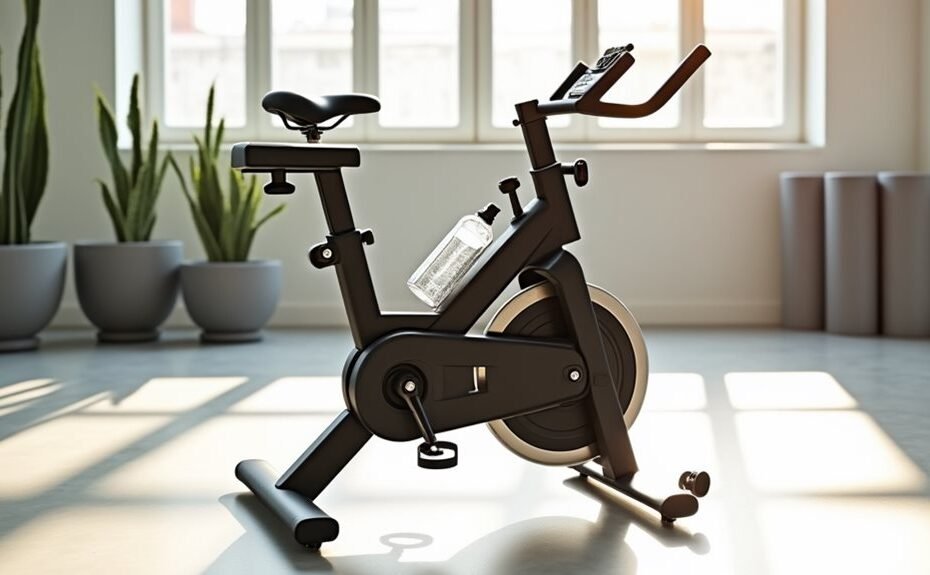I've discovered that my static bike offers far more than just a cardio workout – it's been my secret weapon for developing rock-solid abs. While most people focus on the obvious leg benefits of cycling, I'm here to share how this versatile piece of equipment can transform your core strength through hidden engagement patterns and specialized techniques. Whether you're a dedicated cyclist or just getting started, understanding these lesser-known ab-sculpting benefits will revolutionize your approach to indoor cycling and help you achieve that coveted core of steel.
Key Takeaways
- Standing pedaling intervals intensify core activation while burning calories, creating a dual benefit for ab sculpting.
- Maintaining proper posture during cycling naturally engages abdominal muscles and strengthens the entire core region.
- High-resistance cycling activates deep core muscles, helping develop strength and stability while improving power transfer.
- Alternating between seated and standing positions creates dynamic core engagement, targeting multiple abdominal muscle groups.
- Combining static bike workouts with targeted core exercises maximizes ab-sculpting results and enhances overall cycling performance.
Why Static Bikes Target Abs
Through continuous pedaling movements, stationary bikes engage multiple muscle groups that contribute to core strength and stability. I'll tell you exactly how this operates: Every time you pull up on those pedals, your hip flexors contract, setting off a chain reaction that ignites your entire core. It's not just your legs doing the heavy lifting – your abs are quietly putting in extra effort to keep you steady. Proper posture while cycling naturally engages your abdominal muscles for improved balance. A standard 50-minute cycling session with moderate effort can help you burn 417 calories. Upright bike designs specifically enhance core engagement through strategic body positioning.
Here's the twist: When you stand up on those pedals, you're effectively transforming your bike into an ab-sculpting device. Your core has to work double-time to maintain equilibrium and transfer power effectively. I've seen numerous riders overlook this valuable opportunity by remaining seated during their workouts. Don't make that error.
Let's discuss metabolism. While you're pushing through those resistance levels, you're creating a calorie deficit that's vital for revealing those abs. Trust me, it's basic physics – the higher the intensity, the more calories you burn. And when you consciously engage your core during rides, you're essentially getting a two-for-one deal: cardiovascular exercise and abs. Intelligent training isn't about working harder; it's about working more intelligently.
Perfect Posture Builds Core Strength
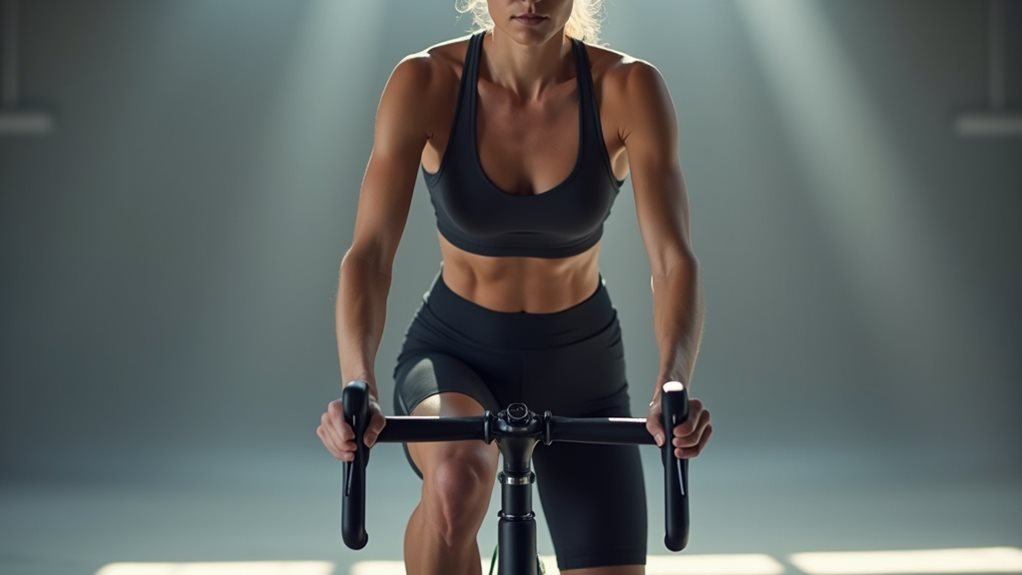
During your static bike workout, maintaining perfect posture isn't just about looking good – it's a powerful core-strengthening strategy. When you engage those core muscles to keep your spine aligned, you're basically creating a natural corset that stabilizes your entire body. Trust me, this isn't just fancy talk – it's pure biomechanics at work.
I'll level with you: Your core isn't just your six-pack. It's a complex system including your transverse abdominis, obliques, and even your pelvic floor muscles. On that bike, they're all working overtime to keep you stable. And here's the kicker – this stability training translates directly to everyday life, from picking up groceries to crushing your tennis game. Controlled movements during exercise help prevent orthopedic injuries and strain. The diaphragm plays a crucial role in maintaining proper breathing patterns while cycling.
Think of your core as mission control for movement. When it's strong, everything works better. You'll notice improved balance, reduced back pain, and better performance in all your activities.
Plus, you're preventing those annoying compensatory movements that lead to strains and sprains. So next time you hop on that static bike, remember: sitting tall isn't just good form – it's your secret weapon for building solid core strength.
Resistance Creates Abdominal Engagement
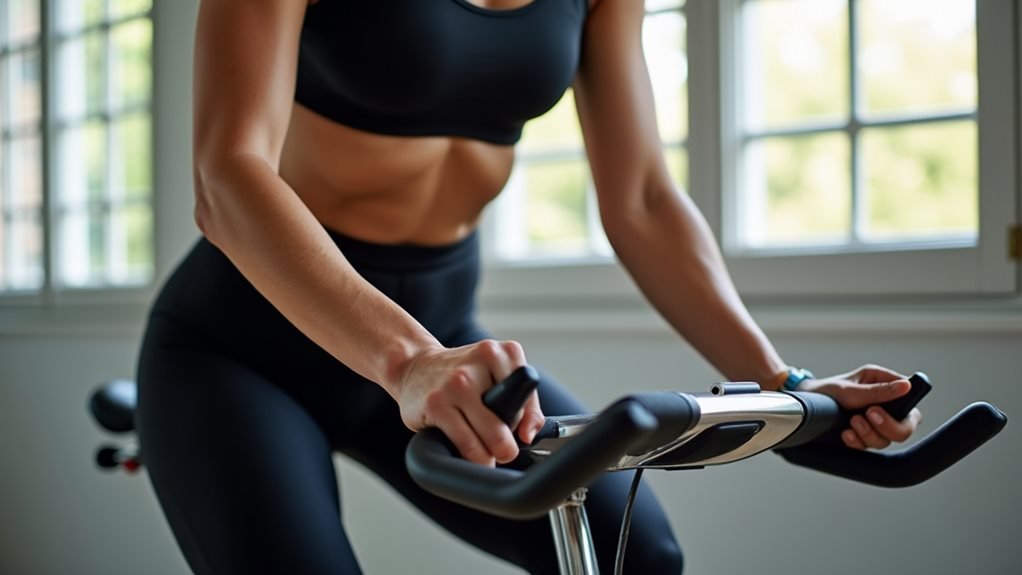
Cranking up the resistance on your static bike does more than torch calories – it ignites serious abdominal engagement. I'm talking about full-core activation that kicks in the moment you push against that increased load. Your hip flexors contract harder, your obliques fire up, and your entire core stabilizes to maintain proper form.
Let's get real about the numbers: At 150 watts, you're burning 417 calories in 50 minutes. Bump that up to 200 watts, and you're torching over 1,000 calories. I'll tell you what that means – more fat loss, more visible abs, and a metabolism that keeps burning long after you've finished. The bike's low-impact nature makes it an ideal choice for protecting your joints while building strength.
Here's the secret sauce: Higher resistance mimics uphill cycling, forcing your body to engage those deep core muscles. I've seen countless riders make the mistake of focusing solely on leg power, but it's the core engagement that's your golden ticket. Studies show that cycling out of saddle maximizes abdominal muscle recruitment during your workout.
Standing Pedaling Powers Core Muscles
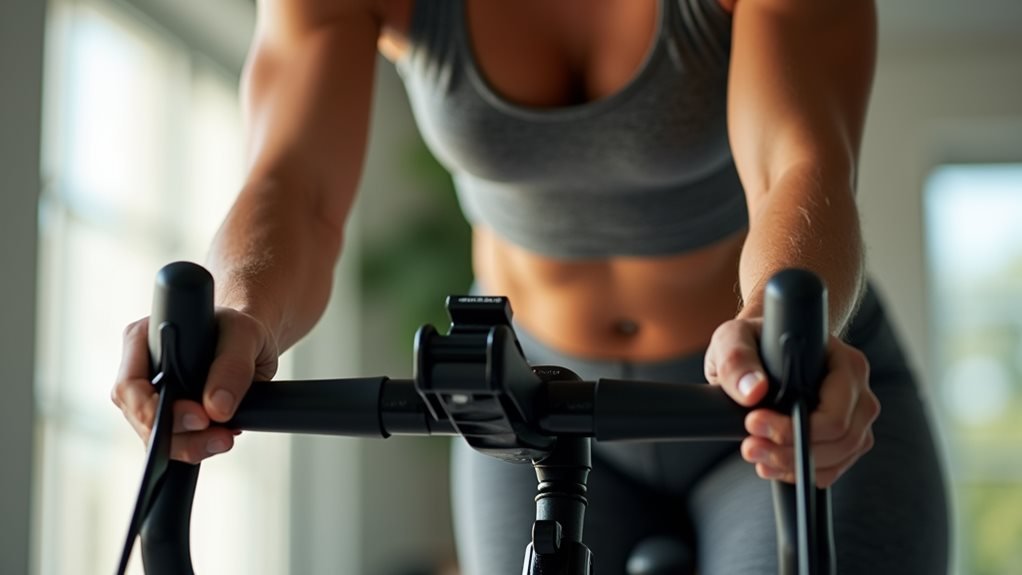
In the midst of your cycling workout, rising from the saddle elevates a standard ride into a full-core power session. I'm talking about serious muscle engagement here – your abs, hip flexors, and lower back immediately spring into action to keep you stable and powerful. Trust me, there's a reason why pro cyclists don't just sit there like couch potatoes.
Let's get real about what's happening when you stand: your core becomes command central for power transfer. It's not just about looking good (though that's a nice bonus) – it's about channeling every watt of power from your legs straight to those pedals. I've seen countless riders waste energy with weak cores, but here's the kicker: standing pedaling fixes that fast. The increased power output you'll experience makes every pedal stroke more effective. Proper core stability is crucial for maintaining efficiency during long rides.
You're also doing your back a massive favor. While other riders complain about lower back pain, you'll be building a natural support system. Those abs of yours are working overtime to protect your spine, and that's exactly what we want.
Plus, you'll develop the kind of balance and stability that makes shifting between positions feel like second nature.
Cross-Training With Static Bikes
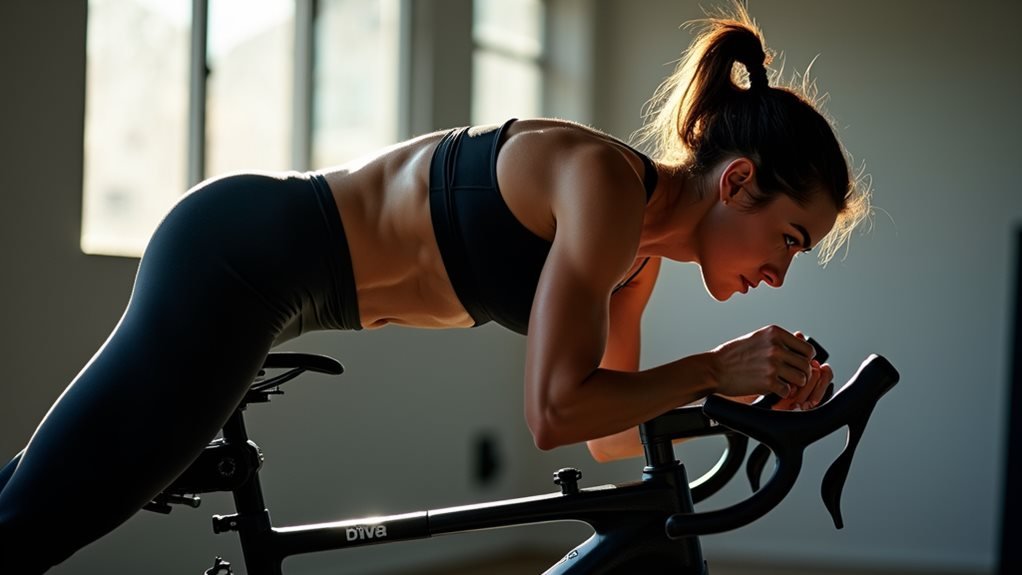
A static bike serves as your secret weapon for cross-training success. I'll show you why it's your smartest choice for maintaining fitness while preventing injury. Unlike running's harsh impact on your joints, cycling delivers cardiovascular benefits without the wear and tear – perfect for recovery days or injury rehabilitation. You'll experience up to 14 hours of continued calorie burn after your session. Regular training helps slow wave sleep, promoting optimal recovery and performance. Low-impact cardiovascular exercise also supports joint health and overall fitness improvement.
Let's get tactical. You'll want to mix high-intensity intervals with steady-state sessions. I recommend starting with 20-minute LISS workouts, then graduating to HIIT once you've built your base. The beauty? You're strengthening those lower body powerhouses – quads, hamstrings, calves – while your joints thank you for the low-impact love.
Here's the kicker: static bikes aren't just about legs. They're your metabolic maestro, improving insulin resistance better than traditional cardio. But don't get overconfident – you'll still need strength training to counter potential weaknesses in your core and hip flexors. I've seen too many cyclists neglect this essential component.
Track your metrics, adjust your resistance, and watch your fitness soar. Trust me, your body will thank you later.
Core Stability During Sprint Sessions
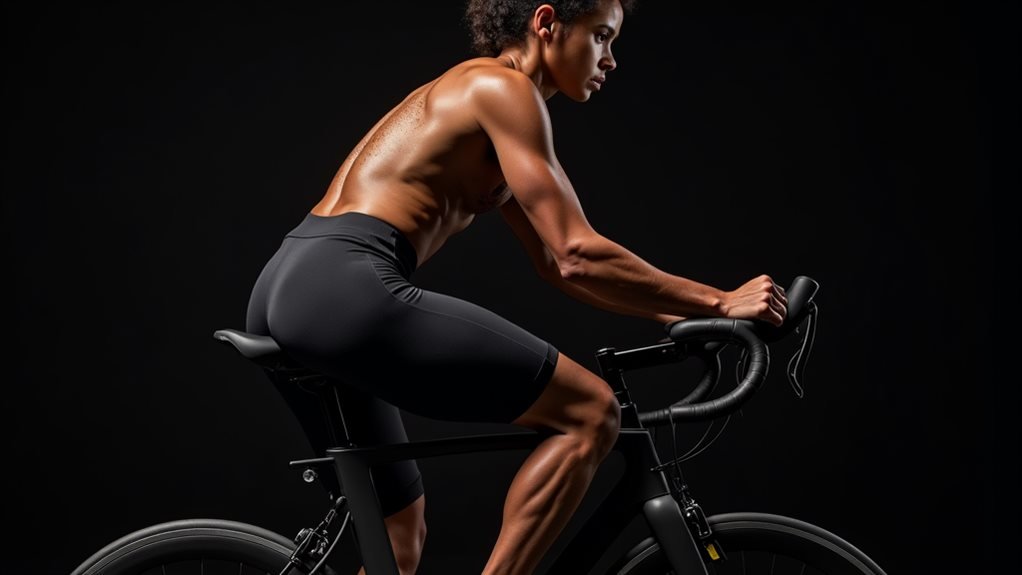
While cross-training builds your foundation, mastering sprint sessions demands rock-solid core stability. I'll tell you why: your core isn't just there for show – it's your power transfer headquarters, eliminating that wasteful side-to-side wobble that's killing your sprint efficiency. High-resistance intervals can specifically target core muscle engagement and improve overall stability.
Let's cut to the chase. I want you doing planks – lots of them. Standard, side, leg lifts – the works. Throw in some bird dogs and hollow holds.
You've got 15-20 minutes? That's all you need, 2-3 times weekly. Do them before or after your ride; I don't care when, just get them done.
Here's the brutal truth: once your core fatigues, your peak torque plummets. Your knees start dancing the cha-cha when they should be tracking straight. Your power leaks away like air from a punctured tire. Trust me, I've seen it countless times – cyclists with weak cores, wondering why their sprints feel like they're pedaling through mud.
Don't let core fatigue rob you of your power. Integrate these exercises now, and you'll thank me when you're holding that aero position like it's your job.
Advanced Ab-Focused Cycling Techniques
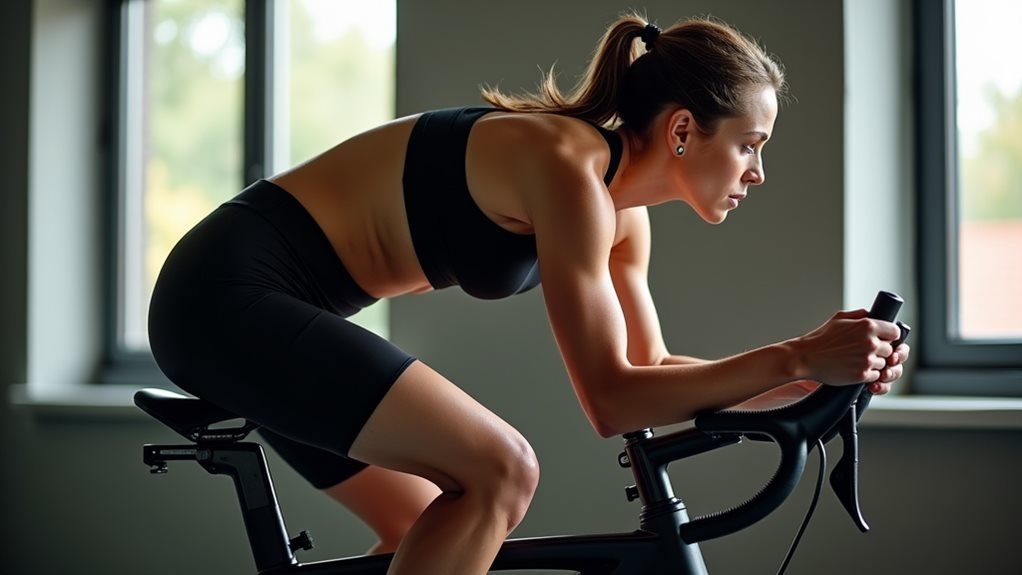
Ready to kick your cycling game up a notch? I'm about to show you how to transform your static bike sessions into core-shredding powerhouses. Trust me, these aren't your average pedal-pushing techniques – they're calculated moves designed to engage your abs while you crush those miles.
- Maintain a plank-like position during sprints, keeping your core tight as a drum
- Drop your elbows slightly below handlebar level to activate those deep abdominal muscles
- Pull your navel toward your spine throughout the entire session – this isn't optional
Let's get technical: I want you to incorporate walking planks and bicycle crunches into your pre-ride routine. These movements prime your core for the real work ahead.
During your ride, alternate between seated and standing positions every 2-3 minutes while maintaining that rigid torso – it's brutal but effective.
Here's the kicker: add Russian twists to your cool-down. They'll reinforce the rotational strength you've built during your ride. Remember, your core isn't just there for show – it's your power center, your stability hub, and your secret weapon for dominating every sprint session.
Frequently Asked Questions
How Long Should Beginners Maintain Proper Form Before Increasing Resistance Levels?
Rome wasn't built in a day, and I recommend you maintain proper form for at least 2-3 weeks before increasing resistance. Focus on mastering basic positioning and breathing patterns first.
Can Static Bike Workouts Replace Traditional Ab-Focused Exercises Completely?
I wouldn't recommend replacing traditional ab exercises with static bike workouts alone. While cycling engages your core, you'll need specific ab-targeting movements to develop thorough core strength and definition.
What's the Recommended Recovery Time Between Intense Core-Focused Cycling Sessions?
I recommend waiting 48-72 hours between intense core-focused cycling sessions to allow proper muscle recovery. For beginners, I'd suggest starting with a full 72-hour rest period.
Are Static Bikes Effective for Targeting Love Handles and Obliques?
I've found static bikes can help reduce love handles and work obliques through standing climbs, high-intensity intervals, and proper form, but they're most effective when combined with targeted exercises and proper nutrition.
Should You Engage Your Core Muscles Differently When Cycling at Varying Speeds?
I recommend adjusting your core engagement based on speed. Use natural engagement at low speeds, maintain steady core support at moderate speeds, and focus on neutral stability during high-intensity cycling.
